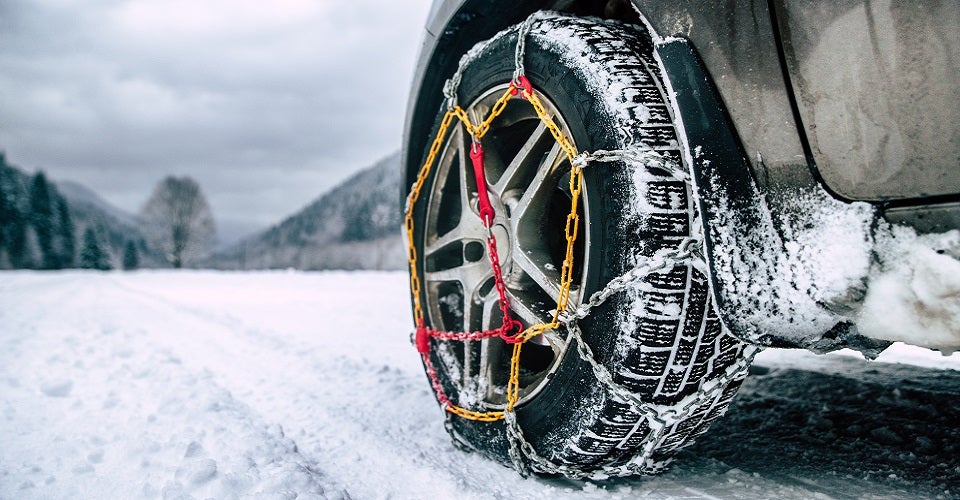
Our Editors independently research, test, and rate what we feel are the best products. We use affiliate links and may receive a small commission on purchases.
Tire chains have long been a standby option for when the going gets tough and rubber won’t meet the road.
Whether you live somewhere remote or simply need some extra grip on roads that would otherwise be treacherous, tire chains are a good choice.
Today we’ll be looking at modern tire chain options. In order to help you make the best choices, we’ll cover the good bad and ugly of tire chain selection.
You can also just browse our list of the top snow chains if you’d rather get right to it and make a decision right now!
For more of my car, truck & 4x4 recommendations, have a look through these popular Outside Pursuits guide links: Winches, Floor Jacks, Vehicle Power Inverters.
Quick Answer: The Best Rated Tire Chains
- Security Chain Company Super Z6 Cable Chains
- Security Chain Company Z-Chain Tire Traction Chain
- KONIG CB-12 Snow chains
- Security Chain Company Quik Grip Light Truck CAM LSH
Our reviews of the top rated tire chains along with our comparison table and buyers guide will help you choose the right set of chains for you.
Tire Chain Reviews
#1 Security Chain Company Super Z6 Cable Chains
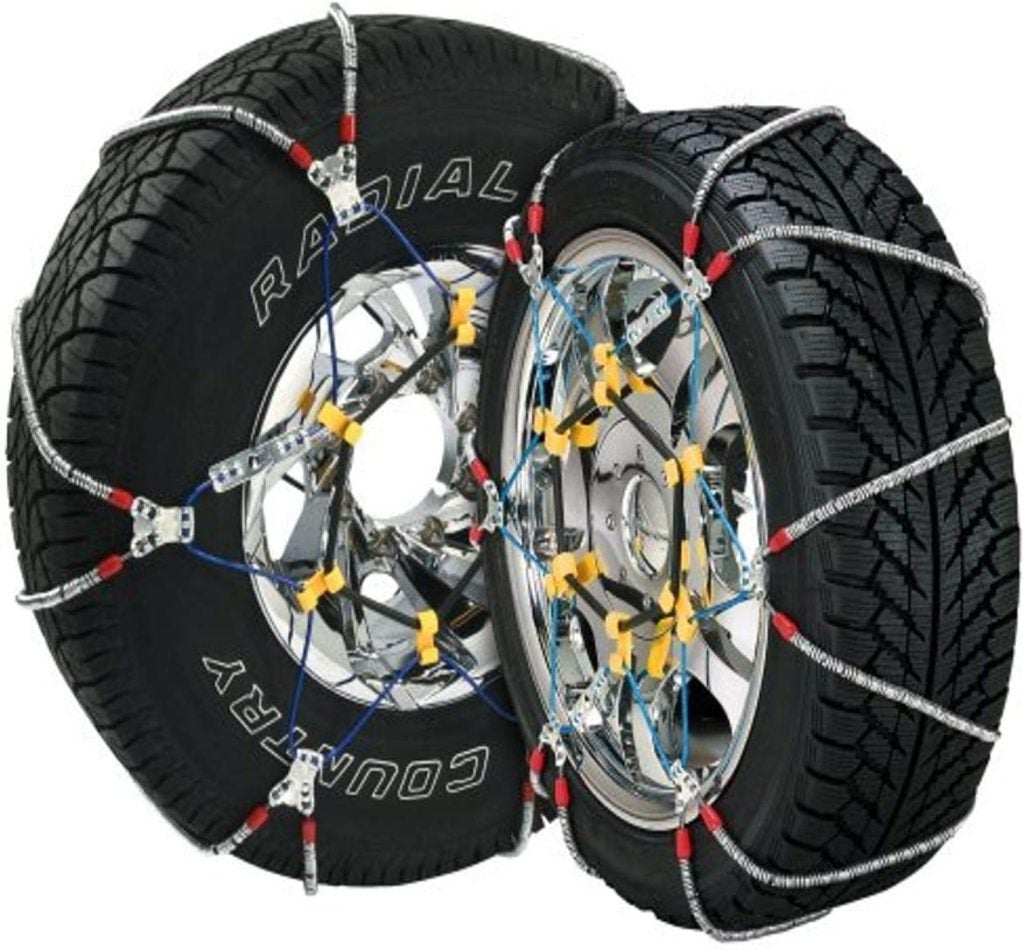
- Chain type: Roller
- Adjustability: Rubberized tensioner
- Clearance class: S
If you’ve got a car, truck, or SUV with very minimal wheel clearance these are the chains you should be looking at!
By far the biggest standout feature on these chains is that they are super slim. They’re made to exceed class S requirements and only need ¼” of clearance on the inside sidewall area.
This is great if your vehicle doesn’t have a lot of room with the wheels maxed out in either direction.
Installation is easy since it doesn’t require you to move the vehicle. You essentially slip the chain around the back of the tire and then connect the clips.
On the outside of the wheel is a rubber tensioner where each clip connects.
This design is self-tightening and will help center itself as you move. Of course, you still need to consult the sizing chart before buying to get the right chains for your tires.
The Super Z6 are the best snow chains for extremely low sidewall clearance tire chains.
#2 Security Chain Company Z-Chain Tire Traction Chain
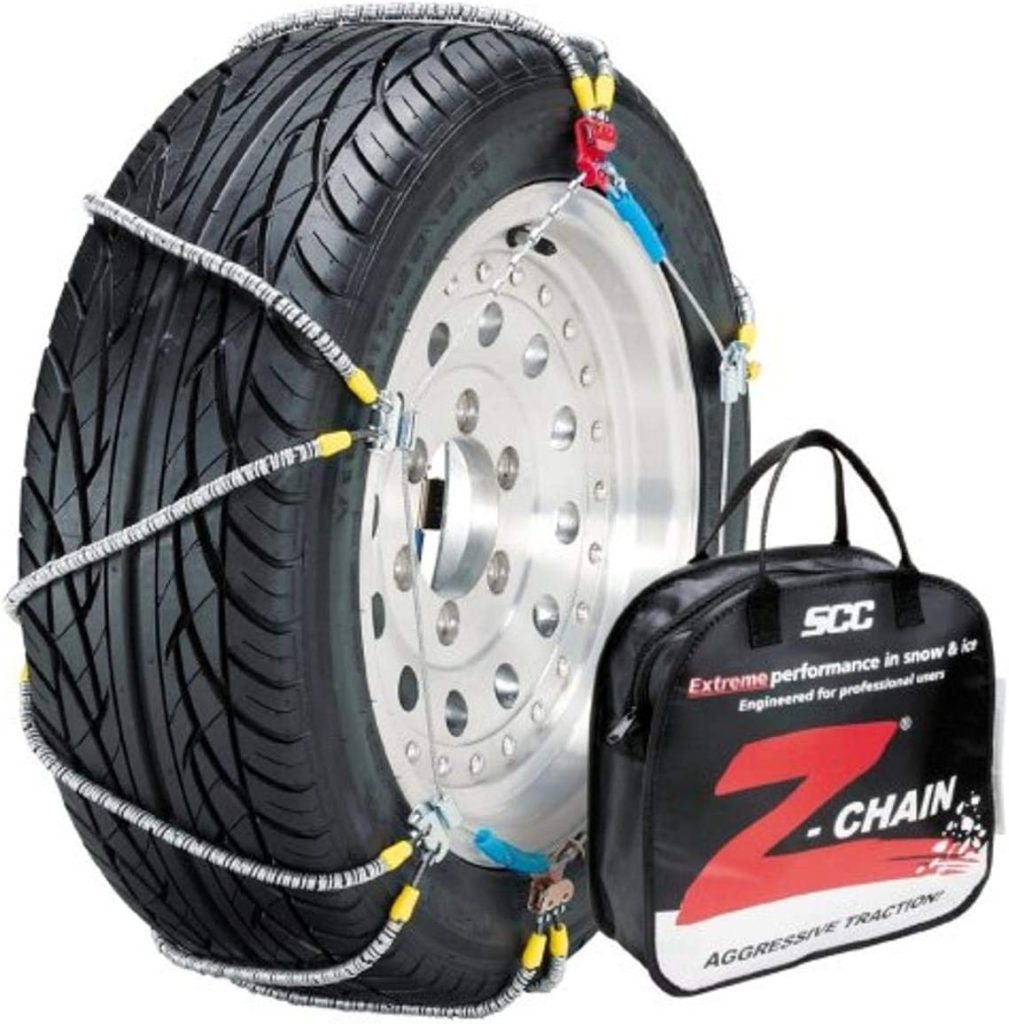
- Chain type: Roller
- Adjustability: Two-piece adjuster
- Clearance class: S
If you’ve got a standard passenger car and rarely encounter bad weather, these chains might be for you.
For those of us who rarely, if ever, need to use our chains we want something light and packable. These chains were designed specifically to roll up and pack away in a small, lightweight package.
There is no moving of the vehicle required to operate these chains.
Unlike the previous model, adjustment is made in two places with external adjusters instead of the rubber ring.
If you don’t like the idea of a rubber adjuster, these might fit the bill. Again, they’re class S chains so they’ll work on even the tightest clearances for compact passenger cars.
Don’t forget to consult the sizing manual to choose your size. Best for small, lightweight storage and occasional use.
#3 KONIG CB-12 Snow chains
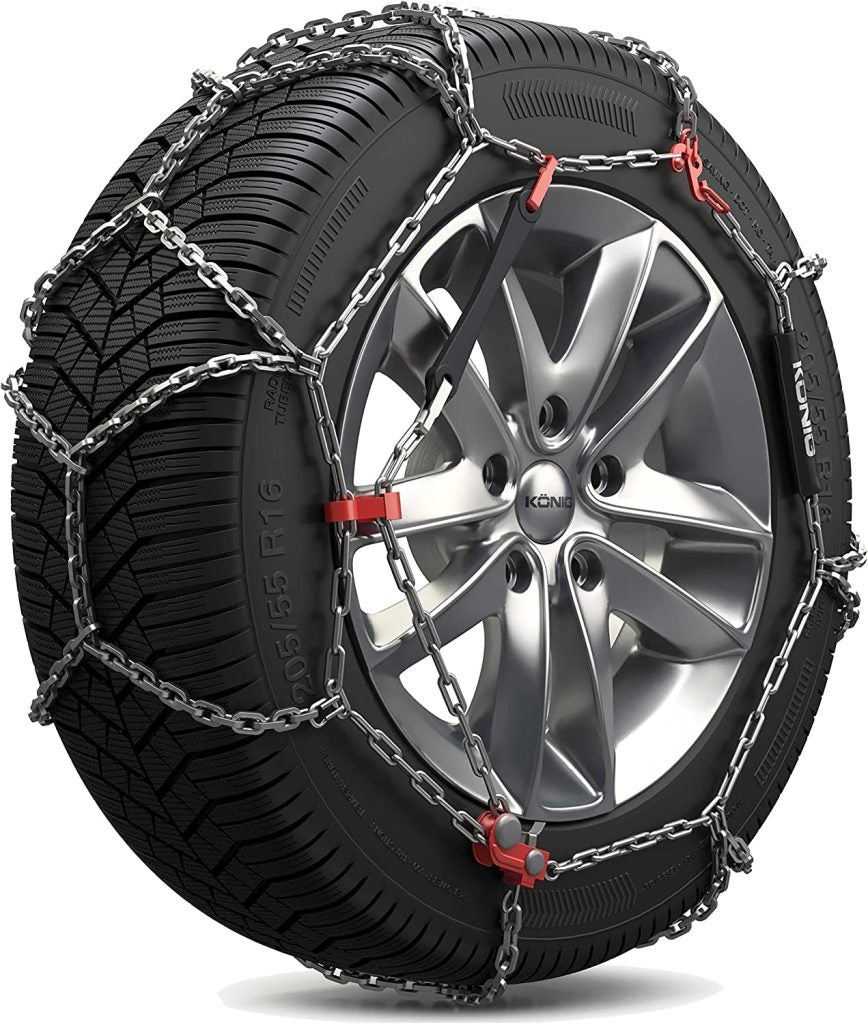
- Chain type: Round link
- Adjustability: Manual
- Clearance class: Unspecified
If you want a beefier chain than the compact rollers we’ve looked at – this one’s for you!
Before we get too deep, let me recommend that you take your time sizing these chains. Some users have complained about inaccurate sizing so be sure to avoid that.
With that out of the way, let’s look at the chains. These are an X-shaped chain pattern. That means they’ll provide some of the best all-around grip of any chain pattern out there.
Unlike the chains we looked at earlier, these are rounded chain links instead of roller chains.
While this may mean a rougher ride and may require greater wheel clearances, the tradeoff is improved grip.
While the adjustment for tightening is manual – it’s pretty easy to do. Just double back the tag end of the chain through the cam and secure it to the rubberized bungee.
If you’ve got a bit of clearance on your tires (clearance tolerances not specified) and you want some good grip, these are an affordable way to do it! These are the best tire chains for SUVs.
#4 Security Chain Company Quik Grip Light Truck Tire Chains
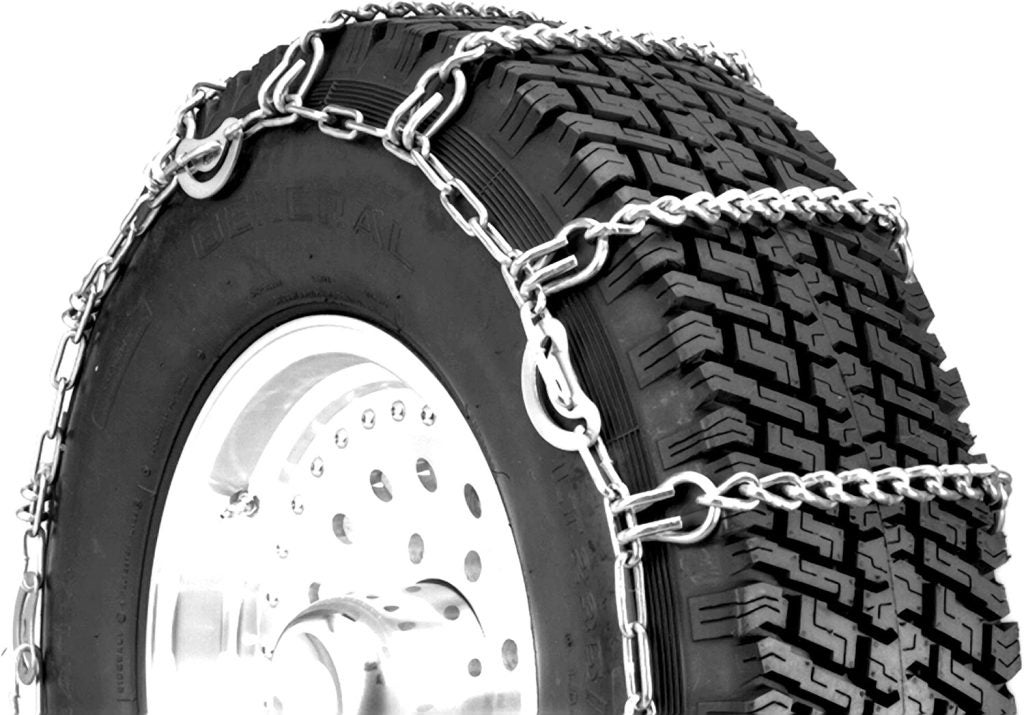
- Chain type: Twisted link
- Adjustability: Cam tensioners
- Clearance class: W
Heavy duty tires, heavy duty trucks, and heavy duty chains just go together. These chains are the right choice for bigger passenger trucks and light commercial trucks in nasty weather.
Note: Clearance class is stated as “DOES NOT meet S.A.E. Class S” however it the product failed to state which clearance class it does meet.
Let’s start with the basics – these are drive-onto style chains. You’ll have to get out, wrap the chain, move forward a bit, connect the chain, and then adjust.
They’re also ladder-style single run chains rather than an X or diamond pattern.
That said, they’re made with beefy twisted chain links. These links are meant to stand up to the torque and pressure of trucks and heavier vehicles.
To get these tightened down you’ll need to use the included cam tightening tool. There are several cam style adjusters around the length of the chain which are used to lock the chains in place. It’s recommended to check the chains for security regularly.
Don’t forget to make sure the size you’re buying is right for your tires! These are the best snow chains for trucks.
How to Choose the Best Snow Chains – Buyers Guide
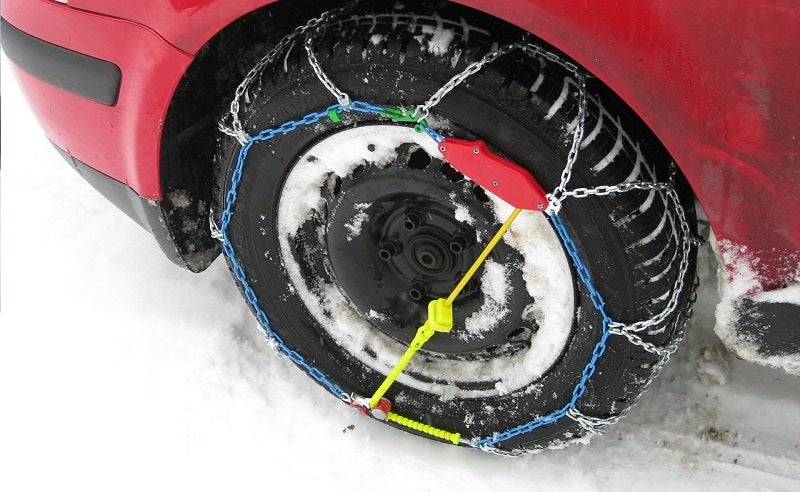
Tire Chain Designations (Class)
Tire chains come in different class ratings. These classes are simple designations relating to the amount of clearance on and around vehicle tires.
Essentially, each class of tire chain is good for various tire clearances. These classes are S, U, and W.
- Class S
- 37mm from tire tread to wheel well
- 15mm from sidewall to vehicle
- Class U
- 50mm from tire tread to wheel well
- 23mm from sidewall to vehicle
- Class W
- 63mm from tire tread to wheel well
- 38mm from sidewall to vehicle
What this means is that the more space you have (think large trucks with big wheel wells) the higher you can go in class. If you drive a vehicle with very little space (think low-rider vehicles) then you’ll have to go lower in these classes.
Of course, low-riders, custom cars, racing vehicles, and the like usually aren’t put into situations requiring tire chains but you get the idea.
The reason these designations are important is to ensure that your tire chains don’t contact parts of the vehicle, wheel well, or underbody when in motion. Particularly when the wheel is fully turned one direction or another, there’s a risk of rubbing or catching the chains.
Tire Chain Sizing
Tire chains are usually made for a narrow range of tire sizes. Because it’s important that the chains fit snugly you can’t go too big or they can become dangerous or ineffective. Of course, under-sizing means they simply won’t fit on your tires at all.
Before you order your tire chains you’ll need to find your tire size.
You can find the size of your tire listed on the rubber tire itself. Go check your vehicle’s tires and you should see a number formatted something like:
200/75R15
Go out and grab this number off of your tires before you go shopping for chains. Write it down and check that the chains you’re buying will cover the size of the tire that you have and then you’ll be good to go!
Installing and Using Tire Chains
Tire chains don’t just magically fit every tire. You’ll have to do a bit of work to get these bad mambajambas to fit and ride correctly.
If you’ve used snow chains in the past you may remember that they can be a bit of a bear to get on. Fortunately, today’s tire chains are much easier to use than those of yesteryear.
Basic manual tire chains are the old standby. You don’t get any assist in sizing and adjusting, just basic chains. Advantages include affordability and reliability. Less complicated parts mean durability but the ease of use is poor at best.
Self-adjusting tire chains are the modern gold standard. They’re quick and easy to install and they quickly self-center and tighten as you drive. There’s no question, however, that they’ll cost you significantly more money than your basic tire chains.
There are tire chains between basic chains and full self-adjusting chains. Some chains have quick-adjust cams or quick-release levers. It’s up to you to find the features that matter the most to you.
My advice is that the more frequently you plan to use your chains, the more money you should spend. If you only use your chains once in a great while or if you are buying chains (just in case) then save some money and go with the simple manual tire chains.
Using Tire Chains in Poor Conditions
One thing to keep in mind is that fancy mechanical adjusters and levers tend not to work in poor conditions. If you get into ice, mud, or packed snow you may find that when you go to adjust or take the chains off that you can’t get them to work.
As we talked about earlier, simple mechanical tire chains (old school style) are by far the most reliable in adverse conditions.
Understanding Tire Chain Styles
Tire chains not only come in different sizes, but they also come in different link shapes and sizes. Some chain links are better for snow, others excel in ice, and yet others are designed to provide the smoothest possible ride.
For the smoothest ride in mild to moderate conditions, roller chains may be your best bet. Like traction rollers for footwear, tire rollers use wrapped spring-style steel to add traction. They’re low-profile and keep your ride smooth so they’re great for passenger cars.
The next step up might be twisted link chains. These chains roll easier than other chains but don’t bit quite as well as some more aggressive chain styles. They have better traction and poorer ride than rollers.
Rounded “traditional” link chains have yet worse ride than a twisted chain but provide better grip. They’re the next step up in terms of traction.
Finally, and most grippy of all… we have square chains. Square chains have a rough, purposely aggressive-edged shape. This shape has tons of traction but comes with the worst and most bumpy ride of all.
Other types of tire chains have added shapes, bumps, welded-on goodies, and a whole assortment of fun stuff for adding traction.
Tire Chain Patterns
Tire chains, at the end of the day, are wrapped around and secured to your tires. How these chains are designed to do this, however, is subject to many different imaginative creations.
Some tire chains simply cross laterally over the tires. Others criss-cross in an X shape. Yet other chains have an asymmetrical pattern.
Similar to how tires are designed, more surface area means more traction. Essentially, the greater number of chains and the more often they criss-cross the better for overall traction.
You’ll find some arguments about different chain patterns and which ones are “the best”. For simplicity’s sake, however, going with a full-coverage chain or a diamond pattern chain is probably most ideal for the widest range of scenarios.
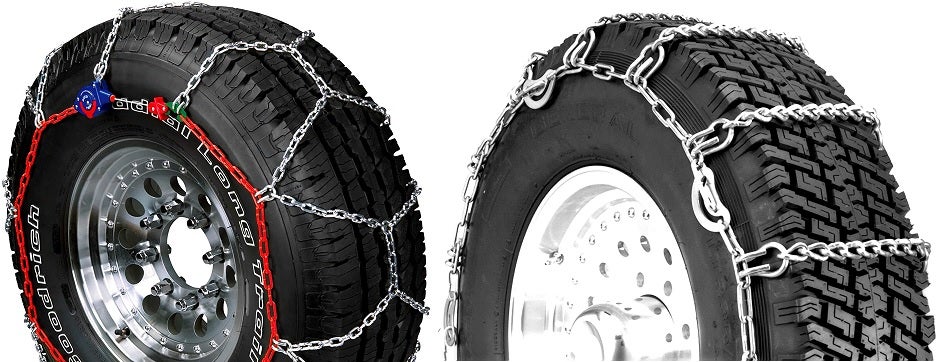
Finding the Right Value for You
Every factor we’ve talked about so far has pros and cons. To help you make decisions, think about your vehicle, and decide which factors are the most important first. For instance, you may have a small passenger car so you have to have low profile chains – you just don’t have a choice.
Now, once the must-haves are out of the way you can make some decisions. For instance, do you want roller chains or D-shaped links? Are you willing to spend the extra money for full-coverage chains?
Probably the most important two factors are:
- How often will you use your chains?
- How inclement is the weather you typically experience?
If you live in the mountains and often drive on sharp curvy roads with very poor conditions then it might make sense to spend top dollar.
If you only occasionally experience inclement weather and you live somewhere flat… maybe save some money and opt for more basic features all around.
FAQs About Tire Chains
Q: Do you need chains on all 4 tires?
A: Usually not.
Most of the time users and manufacturers recommend chains only on the drive wheels. This means on the front tires for most cars and on the back tires for most passenger trucks.
Since you’re usually not going to be driving very fast with chains it’s more important to get traction for acceleration. One thing to keep in mind, however, is that your non-drive wheels won’t have much traction.
If you’re rear wheel drive and you don’t have chains on the front then you may struggle with traction and tracking when turning. Likewise, on front wheel drive vehicles your rear tires could still slide out from under you on turns if they lack traction.
These are some of the reasons why it’s so important to drive slow with chains even if you could go faster.
Q: Do chains ruin your tires?
A: Properly sized and installed chains are not particularly damaging to your tires.
Of course, tires are made from rubber and chains are made from steel. Thus, it’s unreasonable to expect that chains would cause no wear at all on your tires. Chains which cause undue damage or rapid damage, however, are the exception and not the rule.
To help reduce the risk of unnecessary damage to your tires, be sure to follow the manufacturer’s sizing recommendations. Choosing the wrong size is sure to be a pile of problems!
Q: Are snow chains one size fits all?
A: No. They’re not.
Some snow chains may be adjustable across a wide range of tire sizes. Others have links that can be added or removed to fit various tires.
Ultimately, however, you’ll have to confirm that the brand, type, and size of tire chain you’re buying will work with your tires. There’s a limit to the adjustability of most tire chains so you’ll want to get close to before committing to a purchase.
While many tire chains can be adjusted for length (wheel diameter) most cannot be adjusted for tire width.
Q: How tight should tire chains be?
A: Tire chains should be hand tight. You should not be able to feel or create any excess slop when you slide your fingers under the chains.
Now, each set of chains will be designed to install and adjust slightly differently. Please follow the directions provided by your manufacturer.
At the end of the day, overly tight tire chains usually aren’t a big deal. If you go full roid mode and use a breaker bar lever to overtighten things, there is a chance you could cause damage. However, assuming your tire chains are snug and not flopping loose, they’re probably in the sweet spot.
What does a chain look like that’s flopping loose?
Loose chains make a ton of noise. They hang loose under gravity and you can feel slop in the chain when testing it with a finger.
Additionally, at no point should any chain contact your vehicle body. If you hear your chain chattering, bumping, or slapping the road or the vehicle as if it’s flopping around loosely, stop and adjust immediately.
Many tire chains these days have dynamic tightening systems. Bungee cords, self adjusting mechanisms, and other semi-autonomous tension systems make finding the right tightness much easier.
Q: How fast can I drive with snow chains?
A: Well… again I’m going to recommend that you default to the recommendations laid out in your owner’s manual. That said, here’s an idea:
In general snow chains are made for bare minimum speed. Usually manufacturers will suggest a max speed of anywhere from 15-30 miles per hour with chains on.
Generally speaking, the slower you go the less likely you are to run into problems with your snow chains. More speed means more forces, more wear, and more stress on the chains and tightening components.
If you want your car, your chains, and your tires to last as long as possible then I recommend keeping your speed well within the suggested limits laid out in your tire chain owner’s manual. Tuck the manual in your glove box so you can reference it later!
Remember that tire chains are meant for snowy and icy roads – not dry asphalt or concrete. Chains on pavement are actually a hindrance even at low speeds and should be removed as soon as practically possible for safety and durability.
Q: How do I install tire chains?
A: This video will give you some good tips:
Conclusion
With the right tire chains you will be able to travel safely through snow conditions that you would not otherwise to able to do. So read our guide to determine which set is right for your vehicle and the conditions you will be driving it. Be careful out there!
How We Researched
To come up with the top tire chains, we researched a variety of sources for reviews such as Camping World, Lazy Days, Real Truck and Walmart along with our own personal experience.
We also consulted online magazines for product research and reviews to get as much unbiased information as we could. To help weed out fake reviews we used Fakespot.com to make sure we only looked at genuine reviews.
With so much quality gear available, we had to narrow it down based on what we felt were the best options for the price. The staff authors have a wide and varied background in RV camping, automotive repairs and backpacking.
The authors have decades of experience and are eager to share their knowledge with readers.
To help narrow down the selection we used personal experiences along with recommendations from mechanics and retailers.
After extensive research, we came up with our list to help you choose the right one for you.
Sources
